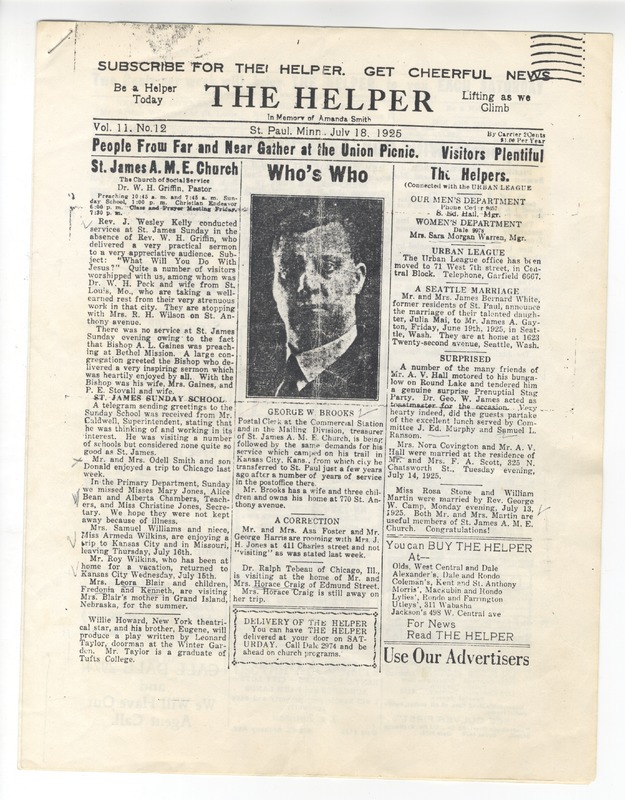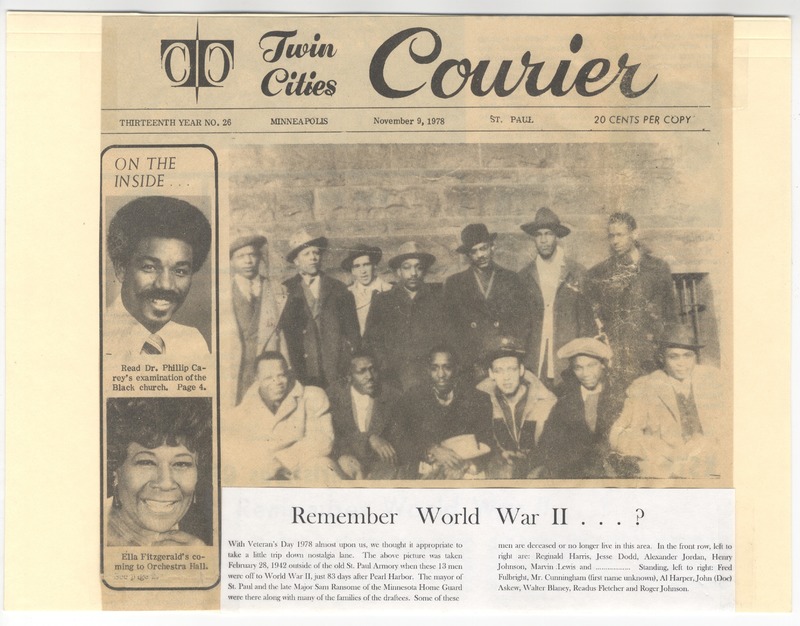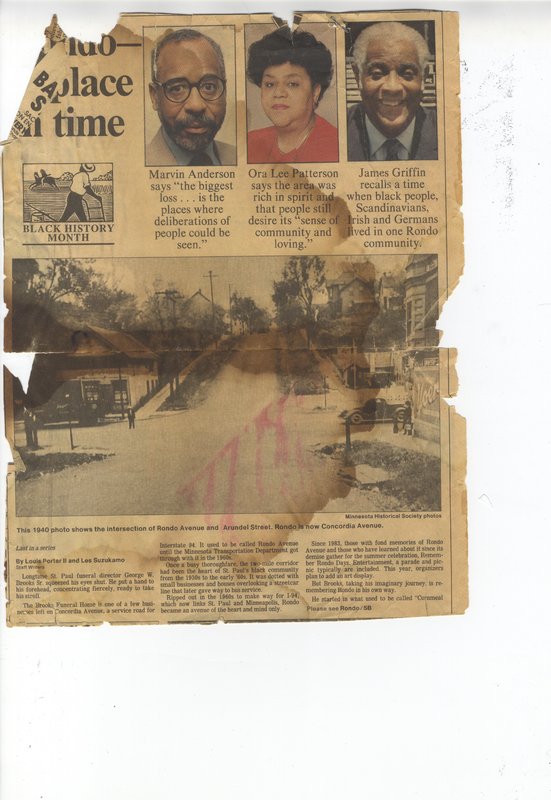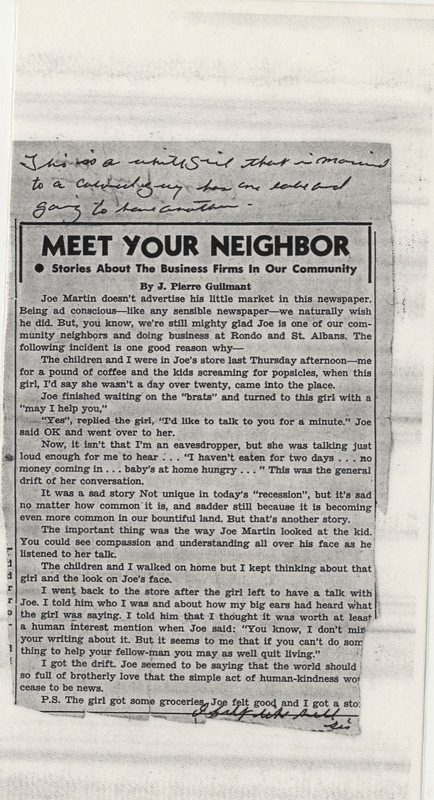Newspaper Publications as a Form of Informal Education
In the book The Voices of Rondo, Mary Boyd discusses the importance of education in the Rondo community, and how it acted as a source of enlightenment. This education took place in more traditional settings, such as schools, but also occurred in more informal ways such as through church, the radio, and newspaper publications. The publications featured in this exhibit illustrate information about local businesses, major events, the geography of the community, the economy, and family/religious values. The Helper newspaper was a local publication that later became known as the Bulletin. On the front page of one of The Helper’s publication, there is information about St. James A.M.E church, local community members, important neighborhood events, and announcements. The newspaper artifact, which was contributed by Vanne Owens Hayes, was published in 1925 and cost one dollar per year. Churches dominate the other pages of the issue, but the publication also helps illustrate the geography of the Rondo community by listing addresses of various businesses, apartments for rent, and community events. The events listed in the publication appear to be very local, rather than national or global, which may speak to the vibrant local community that was present at the time. For community members who had not received a formal education or who were employed, newspapers like The Helper served as a convenient, inexpensive, and reliable form of education.
In the book African Americans in Minnesota, David Vassar Taylor emphasizes the large presence of newspapers throughout various communities across the state. These prints often stayed in publication despite economic conditions, and informed communities (both local and distant,) about things such as upcoming events, politics, and race relations. The Appeal, while started in Minnesota, had a national following, served as a unifying force locally, and gave rise to feelings of pride in the African American community. In a similar fashion, the Twin Cities Courier devoted its pages to the lives, events, and businesses of African Americans in the Twin Cities, and was in publication from 1966-1986. While its reach did not stretch as far as the Appeal's, it was able to educate the Twin Cities community on both local and national events. Readus Fletcher Jr. brought in a 1978 Twin Cities Courier publication about WWII that was published in honor of Veteran’s Day. While this artifact is only one page of the newspaper rather than the whole issue, it still communicates important information about community members and their involvement in events outside of the immediate neighborhood.
Comparing newspapers that were published in different decades allows a present-day reader to see changes in world events, community happenings, and local geographies. It is also important to examine how long various newspapers were in publication, as this can reflect changes in the economy and community values. According to the Minnesota Historical Society’s Black Newspaper Index, The Twin Cities Courier began publication in 1924, and Fletcher’s article shows that it was still in print in 1978. The index also shows that the Helper was not as successful, and stopped publication after a decade in 1925. The longevity of the Twin Cities Courier may be attributed to the fact that it covered both local and global events, and that its targeted audience was the greater Twin Cities area, rather than just the Rondo Community. The Helper may have been less prosperous due to its narrower focus, as it may have only appealed to the population of Rondo.
In the book Folklore of the Freeway, Eric Avila tells the “hidden” story of the freeway revolt, by examining the actions of communities of color, women, and other minority groups in response to freeway construction. Many of the artifacts featured in the digital database focus on the Rondo Community pre-I94 construction, but an article published in the Metro Recorder in 1990 has a more somber tone, and describes a longing for the community that once was. The article was published as a tribute to Black History Month, and features reflections from Marvin Anderson, Ora Lee Patterson, George W. Brooks, and James Griffin. Anderson states that "the biggest loss . . . is the places where deliberations of people could be seen." It is interesting to note that no other artifacts in the database focus on the freeway construction, which may be because people want to remember their community in a positive way. This article appears to be written for a variety of audiences, as it would most likely resonate with Rondo community members, and act as a source of education and enlightenment for those not familiar with the history and destruction of the community. Not only did newspaper publications act as sources of informal education, but they help preserve histories and voices that otherwise may be lost as the Rondo community ages.
While newspaper publications reported community happenings and more global events, they also chronicled the daily lives and interactions among Rondo community members. Michael T. Martin brought in a newspaper article detailing his grandfather Joe Martin’s interaction with a hungry woman who had come into his grocery store, desperate for food. Scribbled in pen at the top of the article is “this is a White girl that is married to a colored guy, has one baby and going to have another.” The author overheard the conversation between the woman and Joe, and featured the shop owner in the “Meet Your Neighbor” column of the newspaper, due to his act of kindness towards someone in need. The sense of pride and admiration the author felt towards Joe becomes clear after reading the article, and these sentiments are echoed in Michael’s oral history, as he speaks fondly of his grandfather. While an interaction like this may not make the news today, it is important to think about why it was published in a local Rondo newspaper in the 1940s. Because the article was featured in a section that provided stories about local business firms in the community, it can be inferred that Rondo residents valued local organizations. When looking at the map of historic Rondo created by Jim Gerlich, it becomes clear that there were many thriving local businesses in the area, and many were located on Rondo Street, where I-94 currently sits. While this particular article may not act as a source of informal education, it does illustrate the relational aspect of the Rondo community, and reflects the values of its residents.
The artifacts featured in this exhibit provide first-hand accounts of various events in the Rondo Community, reflect community values, and illustrate the role of important institutions like the church. Additionally, publications like The Twin Cities Courier show how Rondo was affected by more global events such as WWII, and illustrate that the community did not exist in a vacuum, but was impacted by national and international events and movements. The Metro Recorder’s photograph of Old Rondo shows how the community was affected by the Federal Aid Highway Act of 1956, which transformed other minority communities throughout the country through construction and displacement. The publications featured act as forms of informal education for present day readers, but served the same purpose in the Rondo Community. Prior to widespread internet access, newspapers like the Twin Cities Courier, the Metro Recorder, and the Helper may have been a community member’s only source of information about the world outside Rondo, especially if they did not have the means to own a television set or radio.



